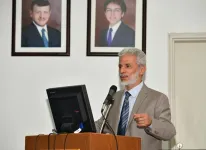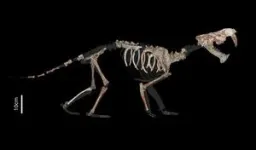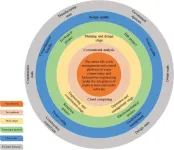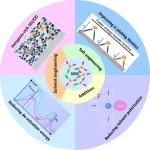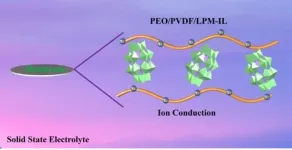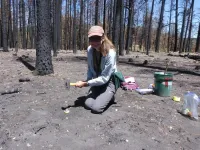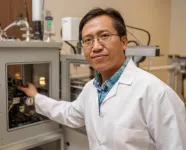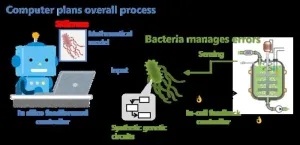(Press-News.org) Jordan ranks second among countries with the lowest access to water and is expected to reach water insecurity by 2030. Within the country, the most water deprived communities live in the Northeast region of Mafraq’s Azraq Basin which is also home to approximately 120,000 resettled Syrian refugees who are dependent on water resources.
A new three-year program called the Global Center on Climate Change, Water, Energy, Food, and Health Systems, led by the University of California San Diego Herbert Wertheim School of Public Health and Human Longevity Science, and supported by an international consortium of universities and community organizations, will address the impacts of climate change in the climate-vulnerable communities in the Azraq Basin.
“The Middle East is the front post or early warning of what a climate change crisis will look like. We need to act now through prevention and preparation to support the region to adapt to and for us to learn from it to prepare the most vulnerable communities locally and globally,” said Herbert Wertheim School of Public Health professor Wael Al-Delaimy, M.D., Ph.D., principal investigator of the Global Center on Climate Change, Water, Energy, Food, and Health Systems.
Funded by a $3.8 million National Institutes of Health (NIH) P20 grant, the program launched in mid-September with 30 scientists from UC San Diego, UC San Francisco, Texas A&M, University of Jordan, Hashemite University, The Royal Scientific Society in Jordan, and six Jordanian community organizations to target rural and refugee communities in the most water-deprived areas of Jordan. The program will address the four core elements of the NIH’s investment in climate health research: health effects research, health equity, intervention research, and training and capacity building.
“This program will provide an important resource for research partnerships and innovation in climate change impacts for disadvantaged communities around the globe,” said Vice Chancellor for Research Corinne Peek-Asa, Ph.D., M.P.H., Distinguished Professor at the Herbert Wertheim School of Public Health.
“It is a testament to our broad interdisciplinary and global footprint in climate and health research that UC San Diego successfully competed for an NIH-funded GeoHealth Hub on Climate Change and Health, and this grant will continue UC San Diego’s leadership in global climate change health impacts.”
Al-Delaimy is the director for the newly funded center as well the GeoHealth Hub and will be representing UC San Diego at the 2023 United Nations Climate Change Conference or Conference of the Parties of the UNFCCC, more commonly referred to as COP28, which for the first time has dedicated a day to address health impacts of climate change.
Given its status as the most water scarce-region, the area with the highest records of extreme heat, extreme income disparities between the very poor and very affluent, and political instability among many of the region’s countries, the Middle East is going to be the epicenter of the climate change health impacts, said Al-Delaimy.
Jordan is one of the few politically stable countries in the region and is aggressively looking for solutions to the water crises and has created a high-profile governmental committee to develop policies that can address this crisis in the short and long term.
Texas A&M University Water Energy Food Nexus Research Group is a partnering university within this center, represented by Rabi Mohtar, Ph.D., professor of Biological and Agricultural Engineering and Civil and Environmental Engineering, and founded the Texas A&M’s Water-Energy-Food Nexus Initiative.
“We are thrilled to receive this support from the NIH. This is an amazing collaboration that will be advancing the field and breaking new grounds by bringing in health as part of the nexus. We will start the initiative in Jordan and then expand it regionally and globally,” said Mohtar.
END
New center addresses global climate change impacts on water, other resources
2023-10-12
ELSE PRESS RELEASES FROM THIS DATE:
NIH research program All of Us establishes CU Anschutz-led Center aimed at better utilizing data
2023-10-12
AURORA, Colo. (October 12, 2023) – The National Institutes of Health’s All of Us Research Program has awarded $30 million to the University of Colorado Anschutz Medical Campus and its partners to establish the Center for Linkage and Acquisition of Data (CLAD). The All of Us Research Program is a historic effort to enroll at least 1 million people who reflect the diversity of the United States. Providing researchers with the data will help drive new discoveries and advance precision medicine.
“This is ...
Team develops HydroBIM platform for design of hydropower hub buildings
2023-10-12
A research team has developed a platform based on building information modeling (BIM) technology for use in the design of hydropower hub buildings. The platform, called HydroBIM, combines BIM technology with geographic information systems, computer-aided engineering, internet of things, artificial intelligence, and other technologies. The HydroBIM platform provides a comprehensive approach to digital design, intelligent construction, and smart operation of hydropower engineering projects.
The work ...
Stronger lithium batteries may need ‘weaker’ solvation structure, researchers report
2023-10-12
Lithium batteries power our phones, computers, many of our cars and so much more — even the drill and weedwhacker. But as technology advances, can they keep up in their current format? No, but there is a way forward, according to a new review paper from researchers at Hong Kong Polytechnic University, by further developing the electrolytes that allow for energy storage and discharge.
The team published their work in Energy Materials and Devices on September 18, 2023.
“Lithium batteries ...
Polyoxometalates and ionic liquid enhance solid-state lithium-ion electrolyte performance
2023-10-12
Polyoxometalates (POMs) containing charged lithium ions combined with ionic liquids, increase the ion conductivity of a solid-state electrolyte membrane.
Solid-state lithium-ion batteries depend on the movement of ions (charged atoms) in the solid, rather than liquid, state to either charge or discharge the battery. These solid-state electrolytes are safer, more cost efficient and capable of higher energy densities than batteries that rely on liquid electrolyte solutions, but suffer from low ionic conductivity, or movement of ions, and poor thermal stability. A new composite ...
New study unveils stretchable high-resolution user-interactive synesthesia displays for visual–acoustic encryption
2023-10-12
The future of human-machine interfaces is on the cusp of a revolution with the unveiling of a groundbreaking technology - a stretchable high-resolution multicolor synesthesia display that generates synchronized sound and light as input/output sources. A research team, led by Professor Moon Kee Choi in the Department of Materials Science and Engineering at UNIST, has succeeded in developing this cutting-edge display using transfer-printing techniques, propelling the field of multifunctional displays into new realms of possibility.
Traditionally, multifunctional ...
The advantage of digital-native brands setting up physical brand stores—and the challenge of preventing sales losses in existing channels
2023-10-12
Researchers from Erasmus School of Economics at Erasmus University Rotterdam, KU Leuven, Universität zu Lübeck, Christian-Albrechts-Universität zu Kiel, and FoodLabs published a new Journal of Marketing article that investigates the multichannel impact of brand stores by digital-native FMCG brands.
The study, forthcoming in the Journal of Marketing, is titled “Assessing the Multichannel Impact of Brand Store Entry by a Digital-Native Grocery Brand” and is authored ...
Extreme habitats: Microbial life in Old Faithful Geyser
2023-10-12
Contributed by Arianna Soldati, GSA Science Communication Fellow
Pittsburgh, Pa., USA: An eruption of Old Faithful Geyser in Yellowstone National Park is a sight to behold. Indeed, millions of tourists flock to the park each year to see it. Hot water and steam are ejected in the air to a height of 100–180 feet approximately every 90 minutes. Many adjectives come to mind to describe it: powerful, mesmerizing, unique, otherworldly . . . homey? Not so much. Yet new research by Lisa M. Keller, published on PNAS Nexus earlier this year and to be presented on Sunday at the Geological Society of America’s GSA Connects 2023 meeting, shows that for ...
Inferring wildfire intensity from quartz luminescence
2023-10-12
Pittsburgh, Pa., USA: On 8 June 2020, the Mangum Fire ignited 16 miles north of the North Rim of Grand Canyon National Park. By the time it was mostly contained, about a month later, the fire had burned over 70,000 acres of land.
April Phinney, a M.Sc. candidate at Utah State University, immediately started drafting a burn intensity map based on remote sensing data. Six months later, she set boots on the burned ground and started collecting soil samples, hoping they would contain quartz grains. This research ...
Cancer Prevention and Research Institute of Texas awards grants to four TTUHSC Researchers
2023-10-12
The Cancer Prevention and Research Institute of Texas (CPRIT) recently awarded grants to four researchers from the Texas Tech University Health Sciences Center (TTUHSC). Combined, the grants will provide nearly $2.3 million that TTUHSC will use to conduct a pair of two-year pilot studies, acquire a state-of-the-art piece of laboratory equipment known as a cell sorter, and administer a colorectal cancer screening and prevention program.
Three of the recipients are from the TTUHSC School of Medicine, including Hongjun (Henry) Liang, Ph.D., a professor in the Department of Cell Physiology and Molecular Biophysics; Min Kang, Pharm.D., a professor ...
Proof-of-concept method advances bioprocess engineering for a smoother transition to biofuels
2023-10-12
One of the primary goals of bioprocess engineering is to increase the yield of the desired material while maintaining high production rates and low raw material utilization. This optimization is usually accomplished by controlling the behavior of microorganisms used in the process and ensuring that their biological capabilities are fully utilized. This control may be computerized (in silico feedforward) or autonomous (in-cell feedback) which predicts the optimization based on inputs received. However, a process-model mismatch (PMM) occurs when there is a discrepancy between the predicted and actual production processes.
A recent paper published in Scientific Reports demonstrates a ...
